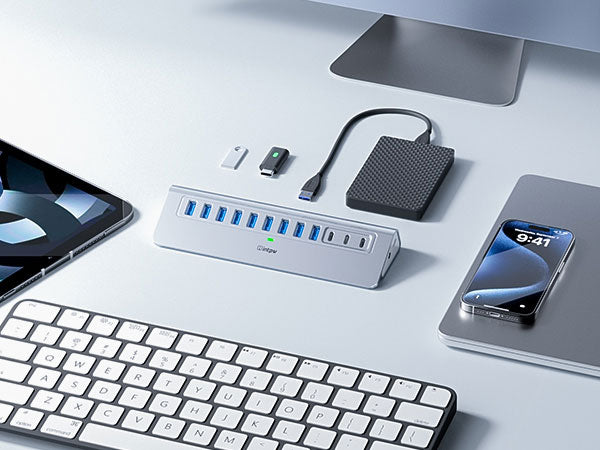
Small Devices, Big Functions: A Deep Dive into USB Hubs and Docking Stations
, by USintpw, 7 min reading time

, by USintpw, 7 min reading time
In today’s world, technology is becoming smaller, faster, and more efficient technology is now compact and packed with powerful features. This trend is especially evident in the world of USB hubs and docking stations. These small but mighty devices play a crucial role in enhancing our workspaces, providing more ports and connectivity options while keeping our setups neat and organized.
But what exactly are USB hubs and docking stations, and how can they transform your tech experience? In this blog, we’ll explore their functions, differences, and the ways they can elevate your digital life.
A USB hub is a device that expands the number of USB ports available on your computer or laptop. Simply put, it allows you to plug in more devices, such as a keyboard, mouse, external hard drives, or even printers, using a single USB port on your laptop or desktop.
USB hubs come in various forms, with a range of features depending on your needs. Some hubs are powered, meaning they supply power to connected devices like external drives or smartphones, while others are unpowered, relying on your computer’s power to run peripheral devices.
A docking station is a more advanced and feature-rich version of a USB hub. While both devices allow you to expand the number of ports on your computer, docking stations often offer more versatility and functionality.
In addition to providing USB ports, docking stations typically include:
Docking stations are often used in office or home office setups, where users need to connect multiple devices, including monitors, storage devices, and other peripherals, all at once.
While USB hubs and docking stations may seem similar at first glance, they have distinct differences in terms of functionality and usage.
USB hubs generally offer additional USB ports (USB-A or USB-C) for connecting basic peripherals like flash drives, printers, or mice. Some hubs even support high-speed data transfer standards like USB 3.0, 3.1, or USB4.
Docking stations, on the other hand, provide more diverse connectivity options. These include multiple USB ports, but they often also offer additional video outputs (HDMI, DisplayPort), Ethernet ports, and sometimes even legacy ports like VGA or audio jacks. They are more suited for users who require a full desktop experience.
While USB hubs can support power delivery for charging devices, most don’t provide the necessary wattage to charge a laptop. A docking station, however, typically supports higher power output, enabling you to charge your laptop, tablet, and other devices all through the docking station itself.
USB hubs are excellent for users who need to add more USB ports to their setup and don’t require additional display outputs or Ethernet connections. They are perfect for individuals working with a laptop that has a limited number of ports.
Docking stations, on the other hand, are designed for users who need to transform their laptop or tablet into a full desktop workstation. They are ideal for remote workers, business professionals, and even gamers who need multiple peripherals, fast data transfer, and dual or triple monitor setups.
Many modern laptops, especially ultra-thin models, come with only a few USB-C ports. If you rely on multiple USB devices, such as a mouse, keyboard, external storage, or webcam, a USB hub can solve this issue by expanding your connectivity options.
With a simple plug-and-play USB hub, you can quickly connect several devices to your laptop without the need to constantly unplug and replug peripherals.
USB hubs are typically smaller and lighter than docking stations, making them perfect for people who are always on the go. If you work in different locations or frequently travel, a USB hub is an easy way to expand your connectivity without carrying a bulky device.
Many hubs are powered by the laptop itself, so you don’t even need to worry about finding an extra power outlet.
USB hubs are generally more affordable than docking stations, making them a great budget-friendly solution for people who need to add more USB ports without investing in a more expensive docking station.
A docking station allows you to easily connect your laptop to a full desktop setup with multiple monitors, keyboard, mouse, printer, and other peripherals. If you are working remotely or transitioning between home and office work, a docking station provides a seamless way to turn your portable laptop into a stationary workstation with just one connection.
With a docking station, you can quickly switch from mobile to desktop mode without the hassle of plugging and unplugging cables.
One of the main benefits of a docking station is the ability to connect multiple monitors. Many docking stations feature HDMI or DisplayPort outputs, allowing you to extend your screen space for enhanced productivity. Whether you’re editing photos, writing reports, or managing multiple spreadsheets, having more screen real estate can make a huge difference in your efficiency.
Docking stations often include Ethernet ports, which can be essential if you need a stable and fast internet connection. Wi-Fi is great for casual browsing, but wired internet is often necessary for video calls, large file transfers, or high-bandwidth activities. Additionally, docking stations usually support audio inputs and outputs, making it easy to connect headphones or external speakers for high-quality sound.
Most docking stations come with power delivery (PD) functionality, meaning they can charge your laptop while connected to your peripherals. This can reduce cable clutter and simplify your workspace, as you don’t need a separate charger for your laptop.
Choosing between a USB hub and a docking station depends on your specific needs.
Go for a USB hub if:
Opt for a docking station if:
As technology advances, both USB hubs and docking stations are evolving. In the future, we can expect:
Faster Data Transfer: With the rollout of USB4, both hubs and docking stations will support even faster data transfer speeds, up to 40Gbps. This will make it easier to work with large files, such as videos, graphics, and backups.
Wireless Connectivity: The future may also see more wireless hubs and docking stations, allowing for cord-free connections to devices. This would further reduce cable clutter and make workspaces even cleaner and more organized.
Improved Charging Solutions: More powerful charging options, such as 100W power delivery, will become the standard for docking stations, allowing for faster charging of devices like laptops, tablets, and smartphones.
USB hubs and docking stations are small devices that pack a big punch. They provide the extra connectivity and functionality needed to enhance your workflow, whether you’re a digital nomad, a creative professional, or just someone trying to keep your workspace organized.
The choice between a USB hub and a docking station depends on how you use your technology and what you need to achieve. While hubs are perfect for adding more ports and are highly portable, docking stations offer a more complete solution for users who need to turn their laptops into powerful desktop setups.
Whatever your needs, USB hubs and docking stations are essential tools that can streamline your tech setup and make your work life more efficient.

Subscribe to our emails